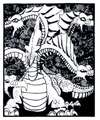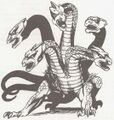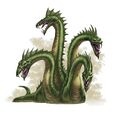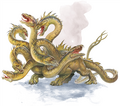Hydra

Hydras are multi-headed dragon-like monsters originating from Greco-Roman Mythology. Described as a many-headed, poison-spewing serpent that could regrow its heads as fast as Hercules hewed them off (tellings differed on whether a neck stump regrew two heads or just the one), so clever Hercules had his nephew Iolaus take a torch to each stump as he severed it, though if he were actually a clever bastard he'd have ignored the heads entirely and just gutted the damn thing. In some versions, one of the heads was immortal and Hercules had to bury it under a boulder. It was natural that such an iconic monster would go on to appear in other fantasy games. A related bit is the Orochi of Japanese myth, which was an eight headed and eight tailed serpent god. A dude named Susano-O killed it by getting it drunk. He then found his girlfriend Kusanagi in the tail.
D&D[edit]
The hydra has been around in Dungeons & Dragons literally since the beginning, having appeared in the Basic Set in 1977 and then going on to appear in the 1981 and 1983 Expert Sets, the 1991 Rules Cyclopedia, and then every Monster Manual from 1st through to 5th. Whilst various details have changed across the editions, the core has remained; hydras are quadrupedal, wingless dragon-kin who possess multiple heads on long, serpentine necks. They can regenerate, and favor swampy environments.
Traditional variants of the hydra include the flame-spewing Pyrohydra, and the frost-spewing Cryohydra. They also have a nasty habit of punching outside of their CR. Their regeneration is very strong and they make a large number of attacks per round. In 3rd edition especially, their rules were created to allow fighters with Cleave and elemental spellcasters to feel stronger, and characters without those abilities to be a strait disadvantage. Similarly, nearly any template put on them made them even more dangerous. Results could include Zombie, where the hydra's pseudo-pounce and very strange version of regeneration (that's technically not lost like the normal kind) negating the templates main weakness making hydras (especially pyrohydras, who can't have their heads permanently severed as zombies) a favorite of necromancer PCs. The Monster of Legend template can also make them literally unkillable short of a Wish spell.
Birthright's take on the monster, which, like all such Birthright monsters is a unique creature rather than a whole race, is particularly nightmarish. Once a simple crocodile that, depending on who you believe, either chowed down on the wrong body or was corrupted to its present purpose by Azrai himself, the Hydra is now ringed by several severed-but-still-semiconscious heads of various heroes and heroines who've tried to destroy it over the years, only to be devoured and subjected to bloodtheft. It's not a super-smart macro-level threat like a lot of other awnsheigh, but it's got a lot of powers up its sleeve from all the heroes it's absorbed over the centuries, and no one knows how to destroy it permanently.
Gallery[edit]
-
Original D&D
-
1e
-
2e
-
-
3e
-
4e
-
5e
-
Pathfinder
Warhammer Fantasy[edit]
Hydras have been a mainstay monstrous unit of the Dark Elves of Warhammer Fantasy. They are extremely tough and vicious creatures that can regenerate and spew fire, but also stupid creatures that depend on Druchii beastmasters to keep them under control. For whatever reason, they also lack the Regeneration special rule.
Warhammer 40k[edit]
While there weren't any monsters similar to Hydras tamed by the Dark Eldar or any of the Tyranids creature with similar biology, but there were a lot of reference to it for the Imperials or just humans in general using the mythical beast as a name to many thing that can be compare to it, be it vehicle or enemies.
The Alpha Legion used the Hydra as a symbol and references to many thing like their legion symbol, their war cry and their fighting tactics. Each marine in the legion is a soldier capable of many roles even being a leader, strike from multiple directions at once, and which could keep going even with the loss of a head. It is unknown if Alpharius (or Omegon) actually encountered a real Hydra before, or at least read about them on some random book written by space traveling Terrans which led to him fascinate with the creatures. Either way, nobody will ever know what the fuck is up with Alpharius and his legion so fuck knows.
Tyranid has a Hive Fleet called "Hydra" living in the Southern part of the galaxy. They are quite small for a hive fleet and their battle tactics revolves around using massive swarms of small tyranid bioforms like Termagants, Hormagaunts and Gargoyles. The bigger synapse creatures (aka Swarm Lord or Hive Tyrant) command these bioform to attack and if the commanding Tyranids died in battle, it will sent some kind of psychic wave across all the small bioforms nearby to attack whoever killed their big dudes (which is like how a hydra lose its head but many take it's place, except the big dudes that died is replaced with a swarm of small Tyranids). This allows them to take down even the big target with just a bunch of small bioforms.
The Imperial Guard has these Hydra Flak Tank which is just Chimera with AA gun and they named like that just because AA gun has many barrels....
Magic: the Gathering[edit]
Hydras have been in M:tG from the very beginning, with Rock Hydra, a card that was discontinued for being both terrible and needlessly complicated. WotC attempted to replace it with Balduvian Hydra, which epically failed because the new card was just as complicated and very slightly more terrible (due to being vulnerable to toughness-reducing effects). Hydras made several more appearances throughout Magic's history, usually favoring Green over Red. A lot of them have an X in their mana cost, meaning they get bigger and better the more mana you dump when you cast them (from a flavor perspective it's like giving them more heads), and almost all of them get +1/+1 counters in one way or another, meaning they can get pretty big. While a lot of them aren't used competitively, there are plenty of notable Hydra cards, especially in recent years such as Hydroid Krasis, a weird mutant jellyfish-hydra abomination from the Simic Conclave, which gives you a load of card advantage and the legendary Progenitus, the ridiculously hard to cast WUBRG Hydra that confuses casuals since it has protection from EVERYTHING (it's the actual card's text).
Monstergirls[edit]
 | This article or section is about Monstergirls (or a monster that is frequently depicted as a Monstergirl), something that /tg/ widely considers to be the purest form of awesome. Expect PROMOTIONS! and /d/elight in equal measure, often with drawfaggotry or writefaggotry to match. |

Ironically, hydras may be the dragon-type monster least likely to get the monstergirls treatment despite their presumed skill at oral sex. Even the Monster Girl Encyclopedia doesn't have a version yet!







